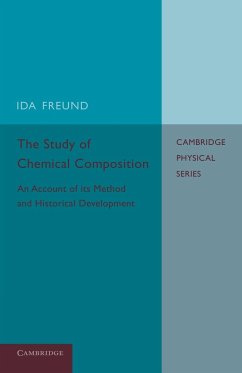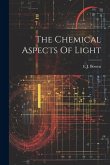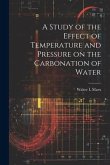Ida Freund
The Study of Chemical Composition
An Account of Its Method and Historical Development with Illustrative Quotations
Ida Freund
The Study of Chemical Composition
An Account of Its Method and Historical Development with Illustrative Quotations
- Broschiertes Buch
- Merkliste
- Auf die Merkliste
- Bewerten Bewerten
- Teilen
- Produkt teilen
- Produkterinnerung
- Produkterinnerung
Originally published in 1904, this book presents an account by Ida Freund of the study of chemical composition.
Andere Kunden interessierten sich auch für
![The Study of Chemical Composition: An Account of Its Method and Historical Development, With Illustrative Quotations The Study of Chemical Composition: An Account of Its Method and Historical Development, With Illustrative Quotations]() Ida FreundThe Study of Chemical Composition: An Account of Its Method and Historical Development, With Illustrative Quotations33,99 €
Ida FreundThe Study of Chemical Composition: An Account of Its Method and Historical Development, With Illustrative Quotations33,99 €![The Principles of Mathematical Chemistry: The Energetics of Chemical Phenomena The Principles of Mathematical Chemistry: The Energetics of Chemical Phenomena]() Georg Ferdinand HelmThe Principles of Mathematical Chemistry: The Energetics of Chemical Phenomena24,99 €
Georg Ferdinand HelmThe Principles of Mathematical Chemistry: The Energetics of Chemical Phenomena24,99 €![An Introduction to the Study of Chemistry An Introduction to the Study of Chemistry]() Ira RemsenAn Introduction to the Study of Chemistry27,99 €
Ira RemsenAn Introduction to the Study of Chemistry27,99 €![The Chemical Aspects Of Light The Chemical Aspects Of Light]() Ej BowenThe Chemical Aspects Of Light20,99 €
Ej BowenThe Chemical Aspects Of Light20,99 €![On The Coagulation Of Colloidal Ferric Hydroxide And Silicic Acid By Chemical Means On The Coagulation Of Colloidal Ferric Hydroxide And Silicic Acid By Chemical Means]() Ray V MurphyOn The Coagulation Of Colloidal Ferric Hydroxide And Silicic Acid By Chemical Means16,99 €
Ray V MurphyOn The Coagulation Of Colloidal Ferric Hydroxide And Silicic Acid By Chemical Means16,99 €![A Study of the Effect of Temperature and Pressure on the Carbonation of Water A Study of the Effect of Temperature and Pressure on the Carbonation of Water]() Walter L. MarxA Study of the Effect of Temperature and Pressure on the Carbonation of Water18,99 €
Walter L. MarxA Study of the Effect of Temperature and Pressure on the Carbonation of Water18,99 €![The Kinetics Of Chemical Change The Kinetics Of Chemical Change]() Hinshelwood C. N.The Kinetics Of Chemical Change22,99 €
Hinshelwood C. N.The Kinetics Of Chemical Change22,99 €-
-
-
Originally published in 1904, this book presents an account by Ida Freund of the study of chemical composition.
Produktdetails
- Produktdetails
- Verlag: Cambridge University Press
- Seitenzahl: 668
- Erscheinungstermin: 27. November 2013
- Englisch
- Abmessung: 216mm x 140mm x 39mm
- Gewicht: 928g
- ISBN-13: 9781107690301
- ISBN-10: 1107690307
- Artikelnr.: 40844689
- Herstellerkennzeichnung
- Libri GmbH
- Europaallee 1
- 36244 Bad Hersfeld
- gpsr@libri.de
- Verlag: Cambridge University Press
- Seitenzahl: 668
- Erscheinungstermin: 27. November 2013
- Englisch
- Abmessung: 216mm x 140mm x 39mm
- Gewicht: 928g
- ISBN-13: 9781107690301
- ISBN-10: 1107690307
- Artikelnr.: 40844689
- Herstellerkennzeichnung
- Libri GmbH
- Europaallee 1
- 36244 Bad Hersfeld
- gpsr@libri.de
Introduction. The method of the inductive sciences. Observation, generalisation and law. Hypothesis and theory
1. Theories of combustion
2. Lavoisier and the law of conservation of mass
3. Exact and approximate laws
4. Bethollet and the law of mass action
5. Proust and the law of fixed ratios
6. Dalton and the law of multiple ratios
7. Richter and the law of equivalent ratios
8. Combining or equivalent weights. Symbol weights
Appendix A. A selection of combining weight values
9. The ultimate constitution of matter. Hypotheses prior to 1800
10. Dalton and the atomic hypothesis
11. Gay-Lussac and the law of the combining volumes of gases
12. Avogardo and the molecular hypothesis
13. Cannizzaro and the application of Avogardo's hypothesis to the determination of molecular and atomic weights
14. Petit and Dulong and the law of atomic heat
15. Mitscherlich and the connection between chrystalline form and chemical composition
16. Mendeleef and the periodic law
17. Kekulé and the doctrine of valency
18. Berzelius and isomerism
19. The ultimate constitution of matter and the genesis of the elements
Index.
1. Theories of combustion
2. Lavoisier and the law of conservation of mass
3. Exact and approximate laws
4. Bethollet and the law of mass action
5. Proust and the law of fixed ratios
6. Dalton and the law of multiple ratios
7. Richter and the law of equivalent ratios
8. Combining or equivalent weights. Symbol weights
Appendix A. A selection of combining weight values
9. The ultimate constitution of matter. Hypotheses prior to 1800
10. Dalton and the atomic hypothesis
11. Gay-Lussac and the law of the combining volumes of gases
12. Avogardo and the molecular hypothesis
13. Cannizzaro and the application of Avogardo's hypothesis to the determination of molecular and atomic weights
14. Petit and Dulong and the law of atomic heat
15. Mitscherlich and the connection between chrystalline form and chemical composition
16. Mendeleef and the periodic law
17. Kekulé and the doctrine of valency
18. Berzelius and isomerism
19. The ultimate constitution of matter and the genesis of the elements
Index.
Introduction. The method of the inductive sciences. Observation, generalisation and law. Hypothesis and theory
1. Theories of combustion
2. Lavoisier and the law of conservation of mass
3. Exact and approximate laws
4. Bethollet and the law of mass action
5. Proust and the law of fixed ratios
6. Dalton and the law of multiple ratios
7. Richter and the law of equivalent ratios
8. Combining or equivalent weights. Symbol weights
Appendix A. A selection of combining weight values
9. The ultimate constitution of matter. Hypotheses prior to 1800
10. Dalton and the atomic hypothesis
11. Gay-Lussac and the law of the combining volumes of gases
12. Avogardo and the molecular hypothesis
13. Cannizzaro and the application of Avogardo's hypothesis to the determination of molecular and atomic weights
14. Petit and Dulong and the law of atomic heat
15. Mitscherlich and the connection between chrystalline form and chemical composition
16. Mendeleef and the periodic law
17. Kekulé and the doctrine of valency
18. Berzelius and isomerism
19. The ultimate constitution of matter and the genesis of the elements
Index.
1. Theories of combustion
2. Lavoisier and the law of conservation of mass
3. Exact and approximate laws
4. Bethollet and the law of mass action
5. Proust and the law of fixed ratios
6. Dalton and the law of multiple ratios
7. Richter and the law of equivalent ratios
8. Combining or equivalent weights. Symbol weights
Appendix A. A selection of combining weight values
9. The ultimate constitution of matter. Hypotheses prior to 1800
10. Dalton and the atomic hypothesis
11. Gay-Lussac and the law of the combining volumes of gases
12. Avogardo and the molecular hypothesis
13. Cannizzaro and the application of Avogardo's hypothesis to the determination of molecular and atomic weights
14. Petit and Dulong and the law of atomic heat
15. Mitscherlich and the connection between chrystalline form and chemical composition
16. Mendeleef and the periodic law
17. Kekulé and the doctrine of valency
18. Berzelius and isomerism
19. The ultimate constitution of matter and the genesis of the elements
Index.









